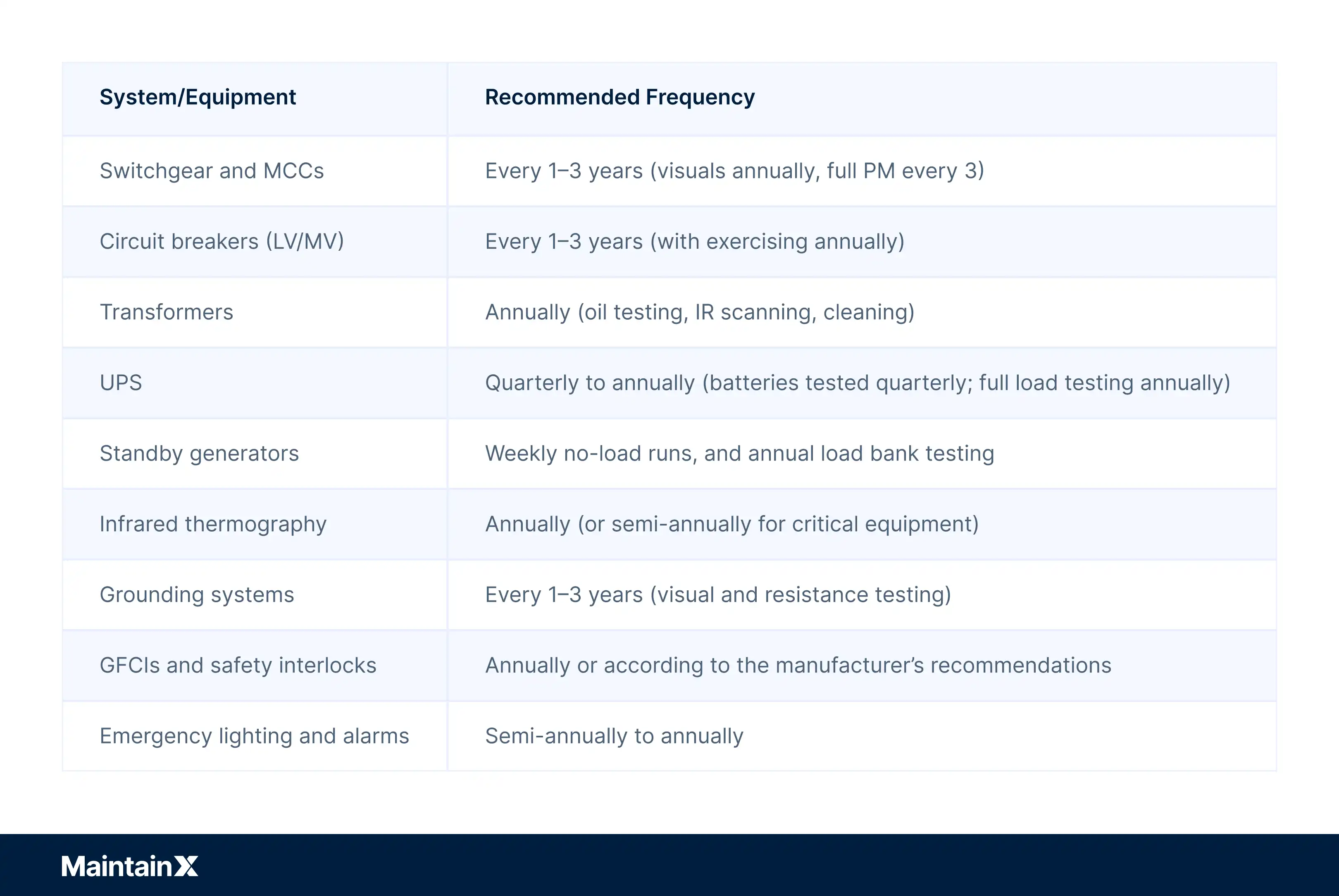
You notice a faint burning smell near the control panel. It’s easy to ignore. But within an hour, smoke starts pouring out of an overloaded breaker. You shut everything down to investigate.
The root cause? No one had checked a 400-amp circuit breaker in months, and the lug connection got loose, overheated, and eventually arced. You could have avoided three days of downtime, thousands in lost revenue, and a visit from the fire marshal with just a simple inspection.
Electrical failures build slowly and quietly until one day, you find yourself dealing with an emergency.
That’s where electrical preventive maintenance (EPM) comes in.
In this guide, we explain what EPM includes, why it matters, and how to build an EPM program to keep your people safe and your facility running without interruptions.
Key takeaways
- EPM is critical because it detects issues with electrical systems before they become expensive failures. It reduces fire risks, unplanned downtime, and code violations.
- An EPM program includes regular inspections, testing, cleaning, and safety checks across breakers, panels, grounding systems, and backup power equipment.
- Documenting your EPM program is as important as performing maintenance. It ensures accountability and regulatory compliance.
What electrical preventive maintenance includes (and why it matters)
EPM includes routine preventive maintenance tasks and inspection of high-stakes systems. Here’s an overview:
- Routine activities: Here’s what regular PM tasks in your EPM program might include:
- Visual inspections: During a visual inspection, your technician looks for signs of overheating, discoloration, corrosion, physical damage, and contamination in panels, switchgear, wiring, insulation, and terminations.
- Thermographic (infrared) scans: Thermographic scans help identify spots that could indicate overloaded circuits, loose connections, or imbalanced loads. These issues are invisible to the naked eye but can lead to failure or fire.
- Insulation resistance testing: An insulation resistance test measures the condition of insulation in cables, motors, and transformers. This helps detect breakdown before arcing or short-circuiting occurs.
- Cleaning: Accumulated dust and grime act like insulation. They trap heat and accelerate wear. Cleaning breakers, contactors, and busbars helps maintain thermal performance.
- Safety system checks: Missing or running behind on maintenance of high-stakes systems poses several risks. Here are some systems you should pay extra attention to:
- Ground fault circuit interrupters (GFCIs): Test them regularly to ensure they trip appropriately and protect your team and workers from shock.
- Emergency lighting and alarm systems: Inspect and test them to assess functionality during outages or emergencies.
- Uninterruptible power supplies (UPS) and generators: Schedule battery tests, load bank tests, fuel checks, and functional run tests to see how these systems perform during a power outage.
- Arc flash and surge protection systems: Review and test to confirm that protective devices operate within designed parameters.
Why EPM matters
Electrical system failures are costly and dangerous. If you fail to notice a loose lug or a tripped breaker, it can turn into a major failure and lead to unplanned downtime, fire, or even injury or loss of life. EPM eliminates these risks.
In addition to promoting safety, EPM:
- Improves reliability: Proactive maintenance minimizes unplanned downtime.
- Increases asset lifespan: Equipment that’s routinely cleaned, tightened, and tested is likely to last longer.
- Helps with compliance: NFPA 70B, issued by the National Fire Protection Association (NFPA), now requires a documented EPM program.
- Reduces maintenance costs: Planned maintenance is always cheaper than emergency repairs and the collateral damage they cause.
- Improves energy efficiency: Faulty or worn-out components consume more power. EPM prevents this and keeps your electrical infrastructure energy efficient.
How often should electrical PM happen?
You should perform electrical maintenance at least annually. Beyond that rule of thumb, your EPM schedule depends on equipment criticality, your operating environment, manufacturer guidance, and standards like NFPA 70B.
Suggested frequencies for common systems
While no specific PM frequency works for every facility, here’s some generic guidance on frequencies for common electrical components and systems:

Factors that influence PM frequency
To determine the right PM frequency for a specific piece of equipment, here are factors you should look at:
- Equipment criticality: Inspect critical power systems, hospital emergency gear, and production-essential motors more frequently.
- Operating environment: Schedule more frequent PMs for equipment operating in hot, humid, dusty, or corrosive environments.
- Load and duty cycle: Perform maintenance more frequently on equipment running near capacity or continuously (such as data center switchgear. This equipment experiences more thermal and mechanical stress.
- Age and condition: Inspect and test older equipment and equipment with a history of faults more frequently.
- Manufacturer’s recommendations: Check the OEM guidelines. They often specify minimum maintenance intervals. Ignoring them can void warranties or lead to a compliance issue.
- Compliance requirements: Check if applicable standards like NFPA 70B, NFPA 70E, and OSHA 1910 Subpart S mandate specific testing or documentation frequencies for your facility type.
Electrical preventive maintenance checklist
Creating an EPM checklist for your facility requires evaluating your equipment’s type, age, and operating conditions, but here’s a general checklist you can use as a starting point:
Visual inspection tasks
Testing and measurement tasks
Cleaning and lubrication tasks
Mechanical and operational tasks
Backup power and safety system tasks
Documentation and compliance tasks
While you’re performing these tasks, you also need to document the following details:
- Asset ID and location
- Date/time and technician details
- Checklist of tasks performed
- Test results and observations
- Any deficiencies or hazards
- Photos (before/after for visual context)
- Next due date or follow-up required
Timestamp all entries and mention the user making that entry to ensure traceability. Most preventive maintenance software solutions allow adding these details.
How to track and document your EPM program
Documenting your EPM program is critical because you may need detailed documentation during:
- Safety audits and compliance inspections (OSHA, NFPA 70B/70E, etc.): Regulators like OSHA or NFPA are checking for more than just the safety of your equipment. They want documented proof that you’re maintaining equipment on a set schedule.
- Warranty and insurance claims: Equipment manufacturers often ask for proof of preventive maintenance to honor warranties. Similarly, insurers may ask for maintenance records when investigating an electrical fire or power-related loss.
- Internal accountability and root cause analysis: You need to know what went wrong and why when an electrical system fails. Documentation gives you breadcrumbs to follow: Is maintenance work overdue on the asset that failed? Did a technician flag an issue that your team never fixed?
The problem? Documentation requires a ton of detail. If you still rely on clipboards or spreadsheets, logging this level of detail will be tedious. A computerized maintenance management system (CMMS) can automate much of the documentation process.
Suppose you just ran an IR scan that detected an overheating panel. If you’re using a spreadsheet, you’d spend the next five minutes logging details into various columns.
On the other hand, if you’re using a mobile-friendly CMMS, you only need to flag the issue. The CMMS records the flag and notifies the designated team or individual, or creates a new work order, based on how you’ve configured it. The CMMS also documents this finding, as well as the subsequent maintenance work performed on the panel.
If you’re in the process of developing your EPM program, start by investing in a CMMS. Try MaintainX for free.
Frequently Asked Questions
What is electrical preventive maintenance (EPM)?
EPM is the routine inspection, testing, and servicing of electrical equipment to prevent failures, improve safety, and increase your equipment’s lifespan.
What is an electrical preventive maintenance program?
An EPM program is a structured plan that defines tasks, schedules, responsibilities, and documentation protocols. It organizes your preventive maintenance efforts and prevents guesswork and chaos.
How often should electrical maintenance be done?
Electrical maintenance frequency depends on the equipment type, operating conditions, and several other factors.





.webp)

_FEATURE.webp)
